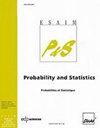相互作用粒子系统的不变测度:代数方面
IF 0.7
4区 数学
Q4 STATISTICS & PROBABILITY
引用次数: 1
摘要
考虑一个连续时间粒子系统ηt = (ηt(k), k∈本文章由计算机程序翻译,如有差异,请以英文原文为准。
Invariant measures of interacting particle systems: Algebraic aspects
Consider a continuous time particle system ηt = (ηt(k), k ∈ 𝕃), indexed by a lattice 𝕃 which will be either ℤ, ℤ∕nℤ, a segment {1, ⋯ , n}, or ℤd, and taking its values in the set Eκ𝕃 where Eκ = {0, ⋯ , κ − 1} for some fixed κ ∈{∞, 2, 3, ⋯ }. Assume that the Markovian evolution of the particle system (PS) is driven by some translation invariant local dynamics with bounded range, encoded by a jump rate matrix ⊤. These are standard settings, satisfied by the TASEP, the voter models, the contact processes. The aim of this paper is to provide some sufficient and/or necessary conditions on the matrix ⊤ so that this Markov process admits some simple invariant distribution, as a product measure (if 𝕃 is any of the spaces mentioned above), the law of a Markov process indexed by ℤ or [1, n] ∩ ℤ (if 𝕃 = ℤ or {1, …, n}), or a Gibbs measure if 𝕃 = ℤ/nℤ. Multiple applications follow: efficient ways to find invariant Markov laws for a given jump rate matrix or to prove that none exists. The voter models and the contact processes are shown not to possess any Markov laws as invariant distribution (for any memory m). (As usual, a random process X indexed by ℤ or ℕ is said to be a Markov chain with memory m ∈ {0, 1, 2, ⋯ } if ℙ(Xk ∈ A | Xk−i, i ≥ 1) = ℙ(Xk ∈ A | Xk−i, 1 ≤ i ≤ m), for any k.) We also prove that some models close to these models do. We exhibit PS admitting hidden Markov chains as invariant distribution and design many PS on ℤ2, with jump rates indexed by 2 × 2 squares, admitting product invariant measures.
求助全文
通过发布文献求助,成功后即可免费获取论文全文。
去求助
来源期刊

Esaim-Probability and Statistics
STATISTICS & PROBABILITY-
CiteScore
1.00
自引率
0.00%
发文量
14
审稿时长
>12 weeks
期刊介绍:
The journal publishes original research and survey papers in the area of Probability and Statistics. It covers theoretical and practical aspects, in any field of these domains.
Of particular interest are methodological developments with application in other scientific areas, for example Biology and Genetics, Information Theory, Finance, Bioinformatics, Random structures and Random graphs, Econometrics, Physics.
Long papers are very welcome.
Indeed, we intend to develop the journal in the direction of applications and to open it to various fields where random mathematical modelling is important. In particular we will call (survey) papers in these areas, in order to make the random community aware of important problems of both theoretical and practical interest. We all know that many recent fascinating developments in Probability and Statistics are coming from "the outside" and we think that ESAIM: P&S should be a good entry point for such exchanges. Of course this does not mean that the journal will be only devoted to practical aspects.
 求助内容:
求助内容: 应助结果提醒方式:
应助结果提醒方式:


